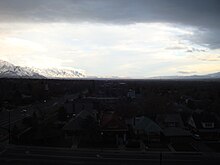Talk:Climate of Salt Lake City
| This article is rated C-class on Wikipedia's content assessment scale. It is of interest to the following WikiProjects: | ||||||||||||||
| ||||||||||||||
The first photograph[edit]

The first photograph in the article, repeated to the right, is titled "Spring storms are common in Salt Lake City." But it does not show a storm, it appears to show a calm sunny day, and the Commons page for it is titled "Salt Lake City on a cloudy April afternoon." So something is wrong. Moreover, unless something serious and incomprehensible has happened to the weather, the top half is overexposed and the bottom half is badly underexposed.
Either there's something wrong with this picture and its captions, or an explanation is needed. Maproom (talk) 21:39, 3 January 2013 (UTC)
External links modified[edit]
Hello fellow Wikipedians,
I have just modified one external link on Climate of Salt Lake City. Please take a moment to review my edit. If you have any questions, or need the bot to ignore the links, or the page altogether, please visit this simple FaQ for additional information. I made the following changes:
- Added archive https://web.archive.org/web/20050503232314/http://www.slcgov.com:80/info/area_info/climate.htm to http://www.slcgov.com/info/area_info/climate.htm
When you have finished reviewing my changes, please set the checked parameter below to true or failed to let others know (documentation at {{Sourcecheck}}).
This message was posted before February 2018. After February 2018, "External links modified" talk page sections are no longer generated or monitored by InternetArchiveBot. No special action is required regarding these talk page notices, other than regular verification using the archive tool instructions below. Editors have permission to delete these "External links modified" talk page sections if they want to de-clutter talk pages, but see the RfC before doing mass systematic removals. This message is updated dynamically through the template {{source check}} (last update: 18 January 2022).
- If you have discovered URLs which were erroneously considered dead by the bot, you can report them with this tool.
- If you found an error with any archives or the URLs themselves, you can fix them with this tool.
Cheers.—InternetArchiveBot (Report bug) 14:00, 26 November 2016 (UTC)
Cfa/Dfa?[edit]
Different sources use different definitions for the C/D climate isotherm. Original system used -3 C, but some modern versions use 0 C. -1.4 C is right between the two, so I feel like the article should include both. Roadguy2 (talk) 21:30, 7 June 2018 (UTC)
Koppen classification[edit]
The Koppen climate class on here has been changed several times over the last few years. I'll go through the calculations from the Koppen climate classification page and explain why I reverted back to Cfa/Dfa:
- The aridity threshold in mm is equal to 20 times the annual average in Celsius, plus 140 if 30-70% of the rain falls in the summer half of the year (which it does in Salt Lake's case). Annual average is 11.6C, so that works to a threshold of 372 millimetres (14.6 in). The 409 millimetres (16.1 in) precipitation exceeds that, so it doesn't belong in a B climate class.
- The C/D distinction is determined by the average temp in the coldest month, and the isotherm is either −3 °C (26.6 °F) or 0 °C (32 °F) depending on which source is used. Since Salt Lake City's coldest month average is 29.5 °F (−1.4 °C), it seems both should be mentioned given the amount of edit-warring that has happened in the past on other pages.
- The dry-summer distinction occurs when the rainfall in the driest month of the summer half-year (April-Sept) is less than a third of the rainfall in the driest month of winter (Oct-Mar). The driest summer month is July with 0.61 inches, while the wettest winter month is March with 1.79 inches. While summer is significantly drier, the factor between them isn't quite 3, so it doesn't qualify for dry summer (the mm in the weather box are rounding approximations). That leaves us with Cfa or Dfa, depending on which isotherm is used. Highway 89 (talk) 22:19, 30 June 2019 (UTC)


